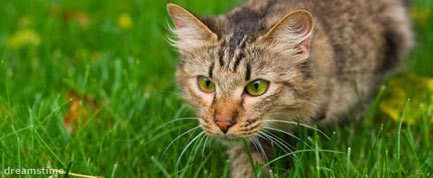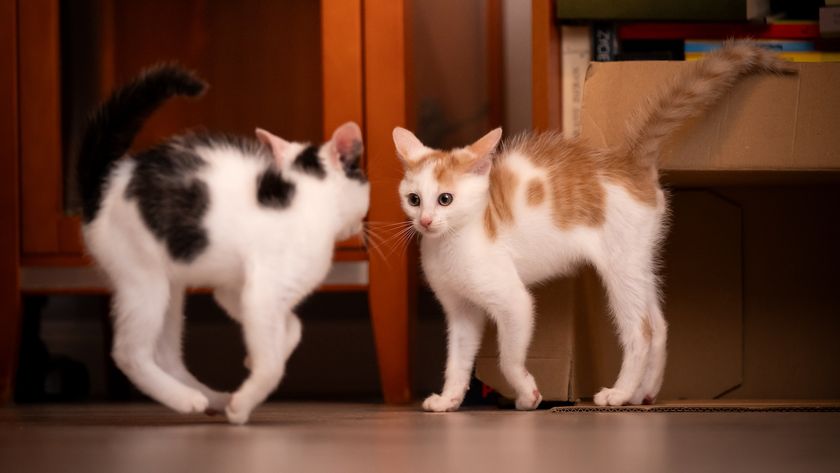Stealthy Cats’ Achilles Heel Discovered

The stealth and balance that cats are known for when they move comes at the expense of energy efficiency, a new study finds, showing that evolution isn't always about efficiency.
"It is usually assumed that efficiency is what matters in evolution," said evolutionary anthropologist Daniel Schmitt of Duke University. "We've found that's too simple a way of looking at evolution, because there are some animals that need to operate at high energy cost and low efficiency."
Namely, cats.
- Video: See How Cats Walk and Stalk
Dogs, humans and horses
Schmitt and his colleagues set out to study the way that cats move, hoping to shed light on the different strategies that animals use to propel themselves. The researchers are particularly interested in how our primate ancestors (and currently living cousins) move, and cats are about the same size as some smaller primates.
Schmitt was curious to see if cats used the same energy efficient strategy that animals such as dogs, horses and even humans use to get around.
Here's how humans walk: As the heel of, say, our right foot strikes the ground, our right hip rises and our leg stays straight. Eventually our hip reaches a high point, before it comes down and the ball of our foot comes down. At that high point, we have a maximum of potential energy; as we drop our leg, "all that potential energy is converted into kinetic energy," Schmitt explained. That kinetic energy propels the left leg forward and makes that leg rise, which continues the cycle of energy conversion.
Sign up for the Live Science daily newsletter now
Get the world’s most fascinating discoveries delivered straight to your inbox.
Dogs and horses use much the same strategy for their four legs, with both the front and back legs rising at the same time, Schmitt told LiveScience.
Schmitt and team member Kristin Bishop (then a postdoctoral researcher at Duke) found that this wasn't the case for cats when they measured and videotaped how six house cats moved along a 6-yard-long (5.5-meter-long) runway in pursuit of food treats or feline toys. The findings are detailed in the Nov. 26 issue of the online journal Public Library of Science.
Slink and stealth
What the team found was that when cats slink close to the ground they walk in a way that "the movements of their front and back ends cancel each other out," Schmitt said. While that's not good for energy efficiency "the total movement of their bodies is going to be even and they'll be flowing along," he added.
"If they're creeping, they're going to put this foot down, and then that foot down and then that one in an even fashion. We think it has to do with stability and caution," Schmitt said.
Even when walking normally, "all happy, tails up," as Schmitt describes it, their movements aren't energy efficient.
"Even that happy walk is more stalk-y than a dog or a horse," Schmitt said.
To put numbers on it, the energy conversion strategy that dogs use can lower the amount of work their muscles have to do by as much as 70 percent. Cats can't get more than a 37 percent reduction and much less than that when they're in stalking mode.
Dogs are large, long-distance predators, so those energy savings come in handy. But cats are small, the energy savings are negligible and they tend to stalk their prey, so they didn’t evolve in a way that prioritized energy efficiency.
"What they're prioritizing is stealth," Schmitt said.
Different, not better
Lest these findings help fuel the debate over whether dogs vs. cats are better pets, Schmitt said, "this really isn't a matter of better," it's just a matter of having different body designs.
Schmitt said he expects that other felines, such as the big cats, employ the same movement strategy as their domesticated feline brothers and sisters, which is the next idea he wants to test.
Other animals that might use a similar strategy to cats could be small opossums and similar animals — "anything that's going to want to be smooth-walking instead of being bouncy," Schmitt said.
Surprisingly though, the primates that Schmitt thought would move similarly to cats — those that walk along branches, as our ancestors would have, and need to "stay low and slinky to keep the branch from shaking" — didn't at all, he said.
In a study of lemurs, Schmitt and his colleagues found that their movement was somewhere in between cats and dogs. Schmitt suspects that this is "because they have exceptionally long limbs" that make it easier to conserve energy while still keeping their balance.
Schmitt's study of cat movement was funded by the National Science Foundation.
- Video: See How Cats Walk and Stalk
- Walk This Way: The Amazing Complexity of Getting Around
- 10 Amazing Things You Didn't Know About Animals

Andrea Thompson is an associate editor at Scientific American, where she covers sustainability, energy and the environment. Prior to that, she was a senior writer covering climate science at Climate Central and a reporter and editor at Live Science, where she primarily covered Earth science and the environment. She holds a graduate degree in science health and environmental reporting from New York University, as well as a bachelor of science and and masters of science in atmospheric chemistry from the Georgia Institute of Technology.











